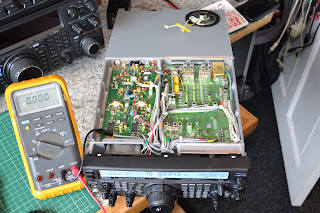I've been fiddling in the shack today with an oscilator I started back here:
http://g0mgx.blogspot.co.uk/2012/06/4m-70mhz-and-counting.html
It's basically an 20MHz crystal oscilator that's multiplied up to 80MHz. I've then fed that into a mixer just like the one used in the BITX here:
http://g0mgx.blogspot.co.uk/2010/12/bitxing.html
And mixed it with the 10MHz reference oscilator I made here:
http://g0mgx.blogspot.co.uk/2011/07/ocxo-oh-you-mean-ocxo.html
The idea being that 80MHz - 10MHz = 70MHz.
There are a couple of amplifier stages in there followed by a (my attempt at) band pass fiter. The iportant thing with mixers is that you get the sum, the difference and all sorts of other harmonic products out, so you have to really filter out the one you want else you just get a real mess!
It all looks rather badly built and like this:
But the output on the spectrum analyser looks like this:
So you can see that the 70MHz signal is the main "feature" in the ouput (It's 10MHz per cm from left to right where the far LHS peak is 0MHz and it's also 10db per cm vertically).
I think I will re-make this with consideration for all the bits and where they need to be; then I'll think about seeing if this will make a transmit converter for 4M.
Good fun, egh?
http://g0mgx.blogspot.co.uk/2012/06/4m-70mhz-and-counting.html
It's basically an 20MHz crystal oscilator that's multiplied up to 80MHz. I've then fed that into a mixer just like the one used in the BITX here:
http://g0mgx.blogspot.co.uk/2010/12/bitxing.html
And mixed it with the 10MHz reference oscilator I made here:
http://g0mgx.blogspot.co.uk/2011/07/ocxo-oh-you-mean-ocxo.html
The idea being that 80MHz - 10MHz = 70MHz.
There are a couple of amplifier stages in there followed by a (my attempt at) band pass fiter. The iportant thing with mixers is that you get the sum, the difference and all sorts of other harmonic products out, so you have to really filter out the one you want else you just get a real mess!
It all looks rather badly built and like this:
But the output on the spectrum analyser looks like this:
So you can see that the 70MHz signal is the main "feature" in the ouput (It's 10MHz per cm from left to right where the far LHS peak is 0MHz and it's also 10db per cm vertically).
I think I will re-make this with consideration for all the bits and where they need to be; then I'll think about seeing if this will make a transmit converter for 4M.
Good fun, egh?





























